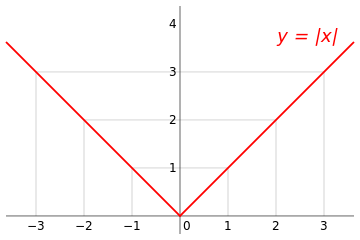What is f(x)?
 Let
f
:
R
→
R
be a function that satisfies the following property.
Let
f
:
R
→
R
be a function that satisfies the following property.
For all x ∈ R , f ( x ) 2 = x 2 .
Consider the following statements.
[ 1 ] . f ( x ) has to be equal to x for all x ∈ R .
[ 2 ] . f ( x ) has to be equal to − x for all x ∈ R .
[ 3 ] . In fact, f ( x ) could be one of three things. f ( x ) = x for all real x , f ( x ) = − x for all real x and f ( x ) = ∣ x ∣ for all real x
[ 4 ] . It is impossible to tell what f ( x ) is.
Which of these statements is correct?
This section requires Javascript.
You are seeing this because something didn't load right. We suggest you, (a) try
refreshing the page, (b) enabling javascript if it is disabled on your browser and,
finally, (c)
loading the
non-javascript version of this page
. We're sorry about the hassle.
3 solutions
Nice question. I misread the third option, overlooking the "for all x" part. Oh well...
Just another comment. If continuity is mentioned, then the third option is the correct one, I think.
Log in to reply
Nope, even then, the third option is incorrect. Remember ( − ∣ x ∣ ) 2 = x 2 ?
Actually it is possible to tell what f is, in the sense that we give a complete characterization of all possible f .
Partition the reals into two subsets A , B arbitrarily. Let f ( x ) = x ∀ x ∈ A and f ( x ) = − x ∀ x ∈ B . This is all the solutions.
To see this, observe that f ( x ) 2 = x 2 implies ∣ f ( x ) ∣ = ∣ x ∣ , so f ( x ) = x ∨ − x . However, there is no way to relate f taken on two different values from just the given equation, so the best we can do is that, f ( x ) = x ∨ − x for all x . The above simply formalizes this, choosing which give positive values and which give negative values.
Since for each real number besides 0 we have two choices for the function, in total we have 2 c such functions where c is the cardinality of the real numbers. Georg Cantor proved that ω < 2 ω for any cardinal number ω , and in particular c < 2 c ; thus we have more functions satisfying this condition than there are real numbers!
This is an awesome solution specially because of the last paragraph. Voted up!
Consider the function f ( x ) = x when x is rational, and f ( x ) = − x when x is irrational. This function satisfies the equation but does not satisfy [ 1 ] , [ 2 ] , or [ 3 ] .
It is impossible to say what f ( x ) is.
f ( x ) could be equal to x in certain intervals while it could be equal to − x in other intervals.
Consider this example.
f ( x ) = { x , if π ≤ x ≤ 2 π − x , if x < π or x > 2 π . .
In fact there are infinite possibilities for f ( x ) and it is impossible to tell what f ( x ) is without any additional information.